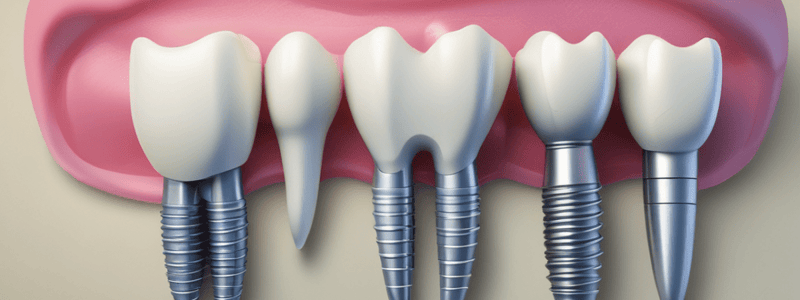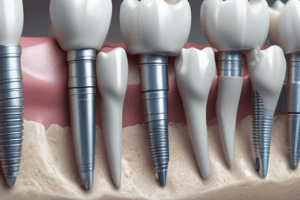Podcast
Questions and Answers
What is the primary function of the hex area in an implant body-abutment connection?
What is the primary function of the hex area in an implant body-abutment connection?
- To provide a microbial seal
- To act as a retentive mechanism and anti-rotation element (correct)
- To distribute the load of the implant
- To facilitate screw tightening
What is a major advantage of internal hex connections over external hex connections?
What is a major advantage of internal hex connections over external hex connections?
- Improved microbial seal and better joint strength (correct)
- Greater platform switching options
- Less historical literature on internal connections
- Higher prevalence of screw loosening
What is a disadvantage of internal hex connections compared to external hex connections?
What is a disadvantage of internal hex connections compared to external hex connections?
- Less screw loosening
- Higher prevalence of rotational misfit
- Weaker designs and diameters in certain cases (correct)
- Inadequate long-term follow-up data
Which of the following is a limitation of external hex connections?
Which of the following is a limitation of external hex connections?
What is a benefit of using external hex connections?
What is a benefit of using external hex connections?
What is the main goal of treatment planning in relation to dental implants?
What is the main goal of treatment planning in relation to dental implants?
What type of load is most destructive to the bone-implant interface?
What type of load is most destructive to the bone-implant interface?
What is the primary function of compressive loads in dental implants?
What is the primary function of compressive loads in dental implants?
What is a factor that affects the load-bearing capacity of implants?
What is a factor that affects the load-bearing capacity of implants?
What type of bone is strongest in compression?
What type of bone is strongest in compression?
What is an advantage of using wider diameter implants?
What is an advantage of using wider diameter implants?
What is the primary function of the original Brånemark protocol?
What is the primary function of the original Brånemark protocol?
What is a limitation of wider diameter implants?
What is a limitation of wider diameter implants?
What happens to the stress level on longer implants?
What happens to the stress level on longer implants?
What is the common range of lengths for dental implants?
What is the common range of lengths for dental implants?
What is the effect of an increase in implant diameter on the maximum value of Von Mises equivalent stress?
What is the effect of an increase in implant diameter on the maximum value of Von Mises equivalent stress?
What is a benefit of using implants with a larger diameter?
What is a benefit of using implants with a larger diameter?
What is the survival rate of ultrawide implants of ≥6 mm in diameter?
What is the survival rate of ultrawide implants of ≥6 mm in diameter?
What was the mean postloading follow-up period in the study of 205 patients?
What was the mean postloading follow-up period in the study of 205 patients?
What is the diameter of the HA-coated implants reported by Griffin and Cheung?
What is the diameter of the HA-coated implants reported by Griffin and Cheung?
What was the overall cumulative survival rate for up to 68 months after loading in Griffin and Cheung's study?
What was the overall cumulative survival rate for up to 68 months after loading in Griffin and Cheung's study?
What is the mean loading period in Anner et al's study of 45 implants?
What is the mean loading period in Anner et al's study of 45 implants?
What is a factor that affects the success of short implants?
What is a factor that affects the success of short implants?
What is the primary focus of osseointegration?
What is the primary focus of osseointegration?
What is the difference between a roughened and a smooth surface implant?
What is the difference between a roughened and a smooth surface implant?
What is zirconia, and how is it produced?
What is zirconia, and how is it produced?
What is the main difference between a one-stage and a two-stage implant approach?
What is the main difference between a one-stage and a two-stage implant approach?
What is the purpose of bio markers such as alkaline phosphatase and osteocalcin?
What is the purpose of bio markers such as alkaline phosphatase and osteocalcin?
What is the term for the process of creating a rough surface on a titanium implant?
What is the term for the process of creating a rough surface on a titanium implant?
What is the function of PGE2 prostaglandin in osteoblast activity?
What is the function of PGE2 prostaglandin in osteoblast activity?
What is the primary difference between a one-stage and a two-stage implant approach?
What is the primary difference between a one-stage and a two-stage implant approach?
What is the role of TGF-β1 in implant placement?
What is the role of TGF-β1 in implant placement?
What is the function of alkaline phosphatase in osteoblast differentiation?
What is the function of alkaline phosphatase in osteoblast differentiation?
What is the characteristic of a tissue-level implant?
What is the characteristic of a tissue-level implant?
What is the purpose of osteocalcin in osteoblast activity?
What is the purpose of osteocalcin in osteoblast activity?
Flashcards are hidden until you start studying




